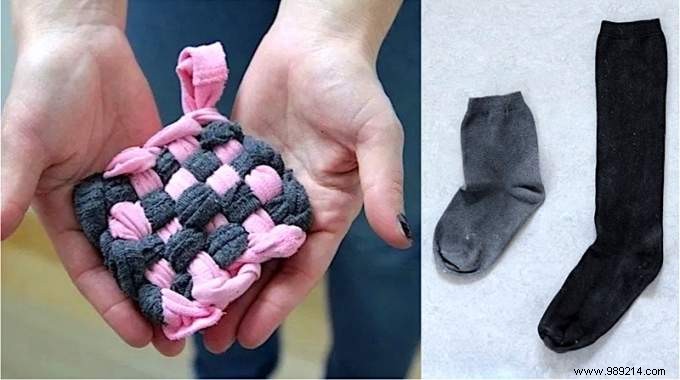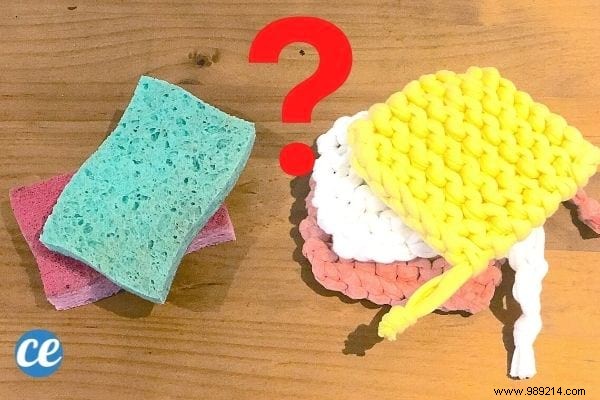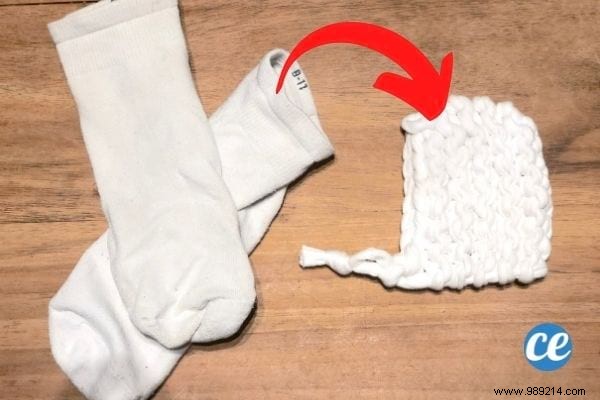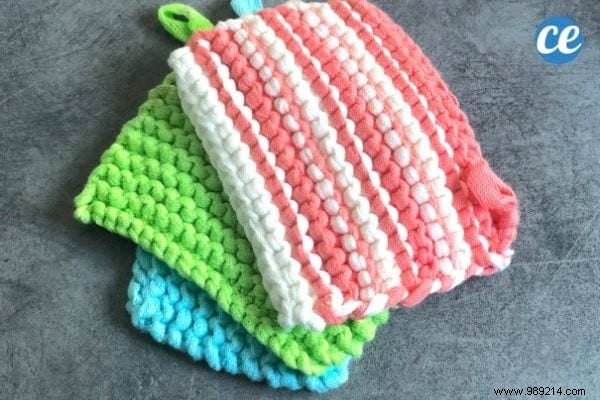
How to make homemade tawashi sponge?
This little homemade recycled fabric sponge is simply amazing.
It's easy to make, zero waste, free and above all...
It cleans everything very well.
A bit of multi-purpose cleaner and hopefully...
We use it to do the dishes but also to wipe the table, the worktop and even wash the car!
In short, it quickly becomes indispensable.
So, how to weave a tawashi ?
Here is the easy tutorial to make your own homemade tawashi sponge . Watch:

- a wooden board (about 20 cm side)
- a pencil
- a square
- 20 flat head nails
- a hammer
- a pair of scissors
- old socks, old leggings or an old pair of tights
1. Draw a 14 cm square on the board.
2. Plant a nail 3 cm from each corner on the outline of the square.
3. Plant the other nails 2 cm apart on the drawn line.
4. Choose your fabric.
5. Cut 10 strips 2 to 3 cm wide to form loops.
6. Place a row of 5 vertical strips stretching them between each nail.
7. Then weave the 1st horizontal strip by passing it over the 1st vertical strip.
8. Then pass it under the 2nd vertical strip and over the 3rd vertical strip and so on until the end of the row.
9. Now weave the 2nd horizontal strip by passing it under the 1st vertical strip.
10. Continue like this, passing once above and once below to the end of the row.
11. Start again with the 3rd horizontal strip by passing it over the 1st vertical strip.
12. Do the same with the 4th and 5th headband.
13. To finish the tawashi, take the last stitch that is in the corner of the top right square.
14. Spread it between your thumb and forefinger.
15. Drag the next stitch into it, i.e. the one on its right.
16. Pull on it a little to pack the weave.
17. Do the same until the last stitch to go around the sponge.
18. Leave the last stitch overhanging to serve as a hook.
There you go, you made your own homemade tawashi sponge :-)
Easy, fast and efficient, right?
You can now use it as a classic sponge.
It is a 100% recycled and very economical sponge.
And rest assured! Making the loom only takes 10 min.
Of course, you keep it for the next times.
However, you can also get a ready-made loom.
And then,weaving your sponge only takes 5 min .
In 15 min, your tawashi sponge is ready!
If you don't have a wooden board, you can use thick cardboard .
In this case, it is necessary to cut 2 or 3 cardboard squares of 20 cm sides.
Glue these boxes on top of each other.
And use high head tacks to replace the nails.

That's a good question!
Simply because using a tawashi sponge is much cleaner...
But that's not all.
It's also more environmentally friendly.
Indeed, German researchers have estimated that each centimeter of conventional sponge contains millions of germs.
According to them, there are at least 73 families of bacteria living together in a sponge.
And some are not very nice... Like Escherichia coli, Salmonella, Staphylococcus...
At the same time, it is normal.
The sponge is a permanently wet object.
And that is already paradise for bacteria.
So if we add the fact that we use sponges to clean the dirtiest things in our house...
You see what I mean ? A real nest of germs!
So, to avoid the proliferation of bacteria, you have to change your sponge often.
But a classic yellow sponge is neither recyclable nor biodegradable.
And the icing on the cake, its production is ultra-polluting.

Let me tell you, it's very very simple!
Even easier than cleaning a classic sponge!
To clean a tawashi sponge, you can machine wash it with your towels.
Alternatively, put it in the dishwasher to clean it at the same time as the plates.
You remember ? We had already seen this possibility for cleaning microfiber cloths.
Whichever option you choose, remember to run a program at 60° to destroy germs and bacteria.
It is also possible to soak it in white vinegar to disinfect it.

You are probably wondering what fabric to use to make your DIY tawashi.
Truth be told, the choice is yours.
The idea is to recycle old clothes damaged, with holes or that you no longer wear.
The ideal is still to have a slightly elastic material.
You can use old leggings, thick tights with holes, used socks or an orphan sock or the sleeves of a damaged sweater or T-shirt.
The fabric should be in the shape of a tube and long enough to be able to cut 2 to 3 cm wide strips from it.
Know that you can use different fabrics to make a single sponge, with different colors.

You might be wondering if there are any downsides to using tawashi sponges?
In my experience, these sponges don't really itch.
It is better to use them to clean surfaces than to pickle a burnt pan for example.
So how do you get a tawashi sponge that also scrubs?
Here's a super clever trick to make an itchy tawashi sponge .
Just replace some fabric strips with plastic strips taken from an onion net.
And you get a scratchy tawashi.
Handy for cleaning a very dirty pan or dish!
In addition, they take longer to dry than a classic sponge.
Otherwise, it's great for natural and zero waste cleaning!

There are of course several techniques for making a tawashi sponge.
It can be crocheted, without using a nail.
In this case, its shape is often round.
The advantage is that you can choose the yarn to make your tawashi sponge.
It's handy if you can use an itchy sponge.
You can choose sisal yarn or hemp rope.
Have you heard of the Creative Bubble? It's this rough thread that scratches a little.
As a result, it is very effective for cleaning encrusted dirt and washing dishes.
But in my opinion, this is not the best option.
You should know that this wire is made of plastic material.
Over time, it deteriorates and dissolves into small plastic particles.
Not great for the dishes, nor for the environment!
And of course, you have to master a minimum of the crochet technique.
If you like knitting, know that you can also knit your sponge .
In that case, why not use Trapilho yarn?
Find out how to do it here.

By the way, where does this sponge with the weird name come from?
As its name suggests, a traditional tawashi sponge is a sponge of Japanese origin.
It means approximately "mop", "gratounette", "washing brush"
It is a zero waste sponge that we make with old fabrics.
It is then used to do the dishes, wash the worktop, wipe the table...
As it is washable, it can be reused many times, without the risk of spreading germs and bacteria throughout the house!
It is therefore practical, ecological and economical.
Note that you can also buy tawashi sponges.